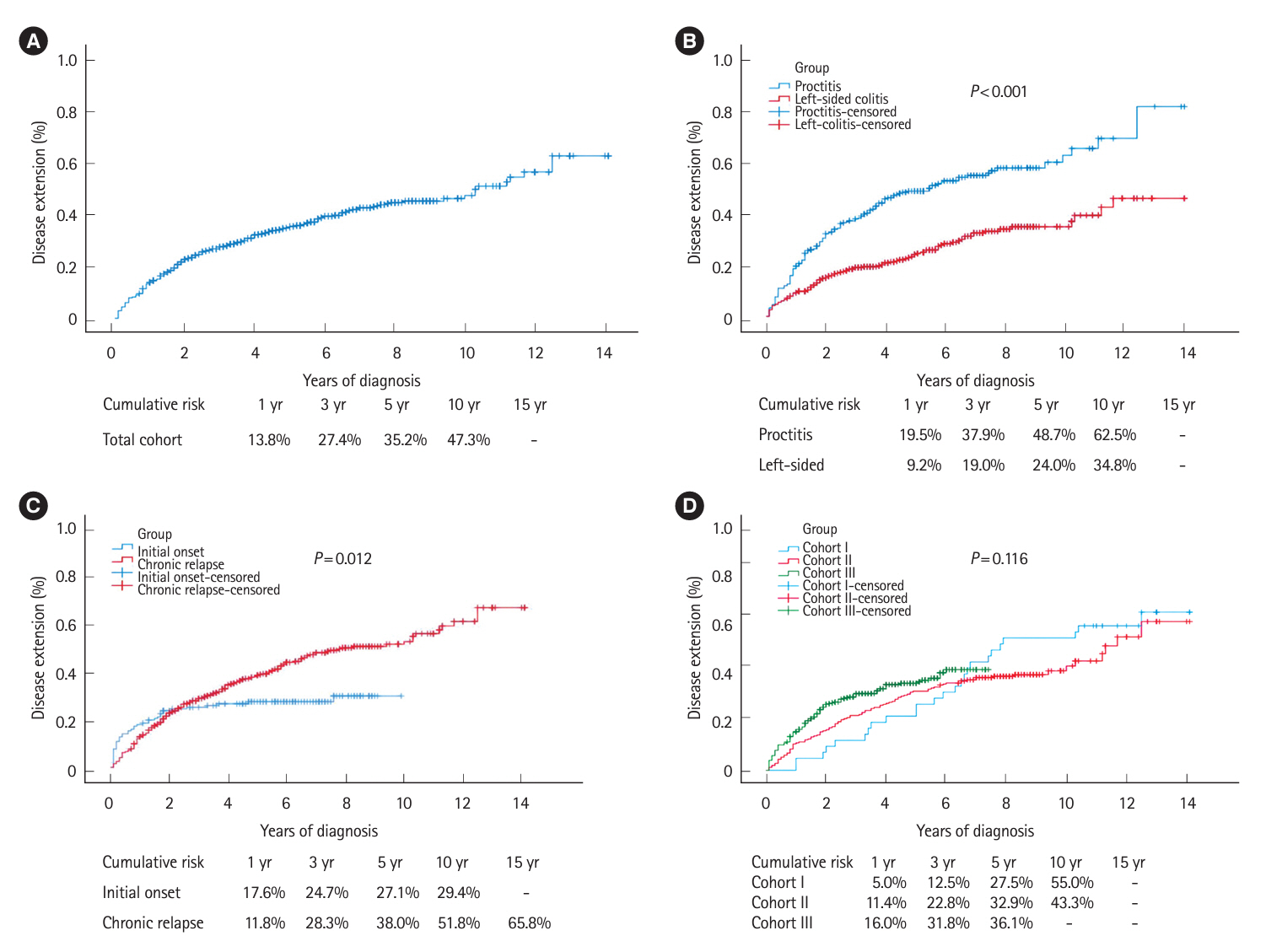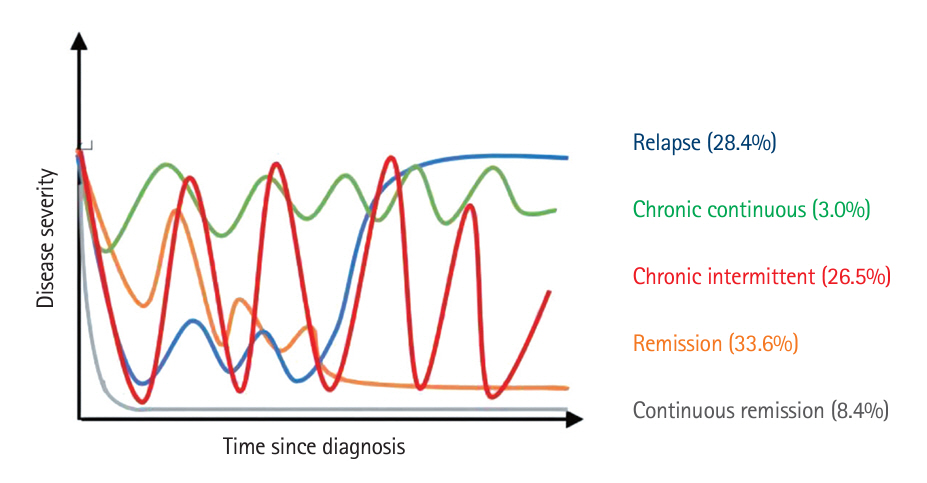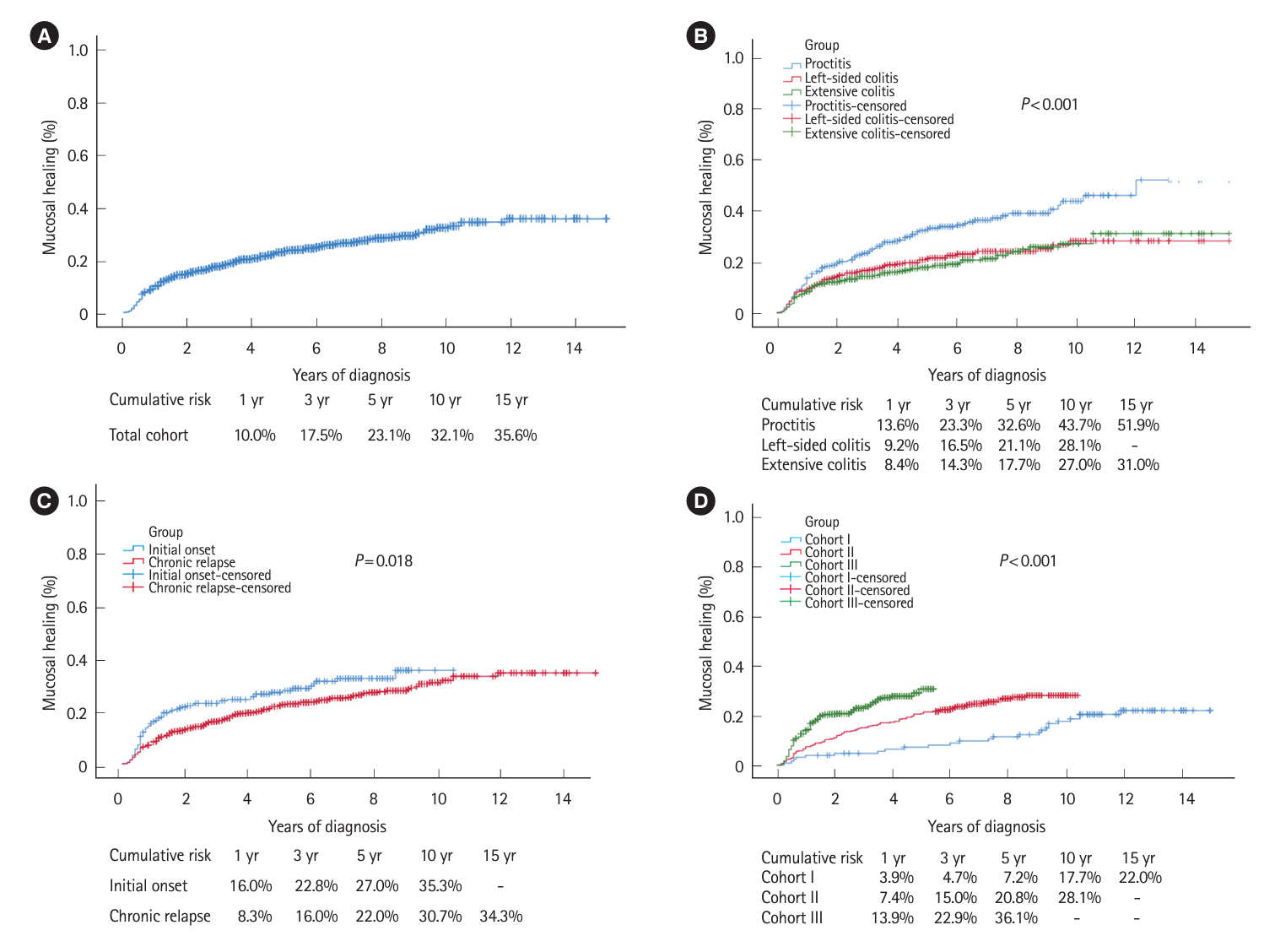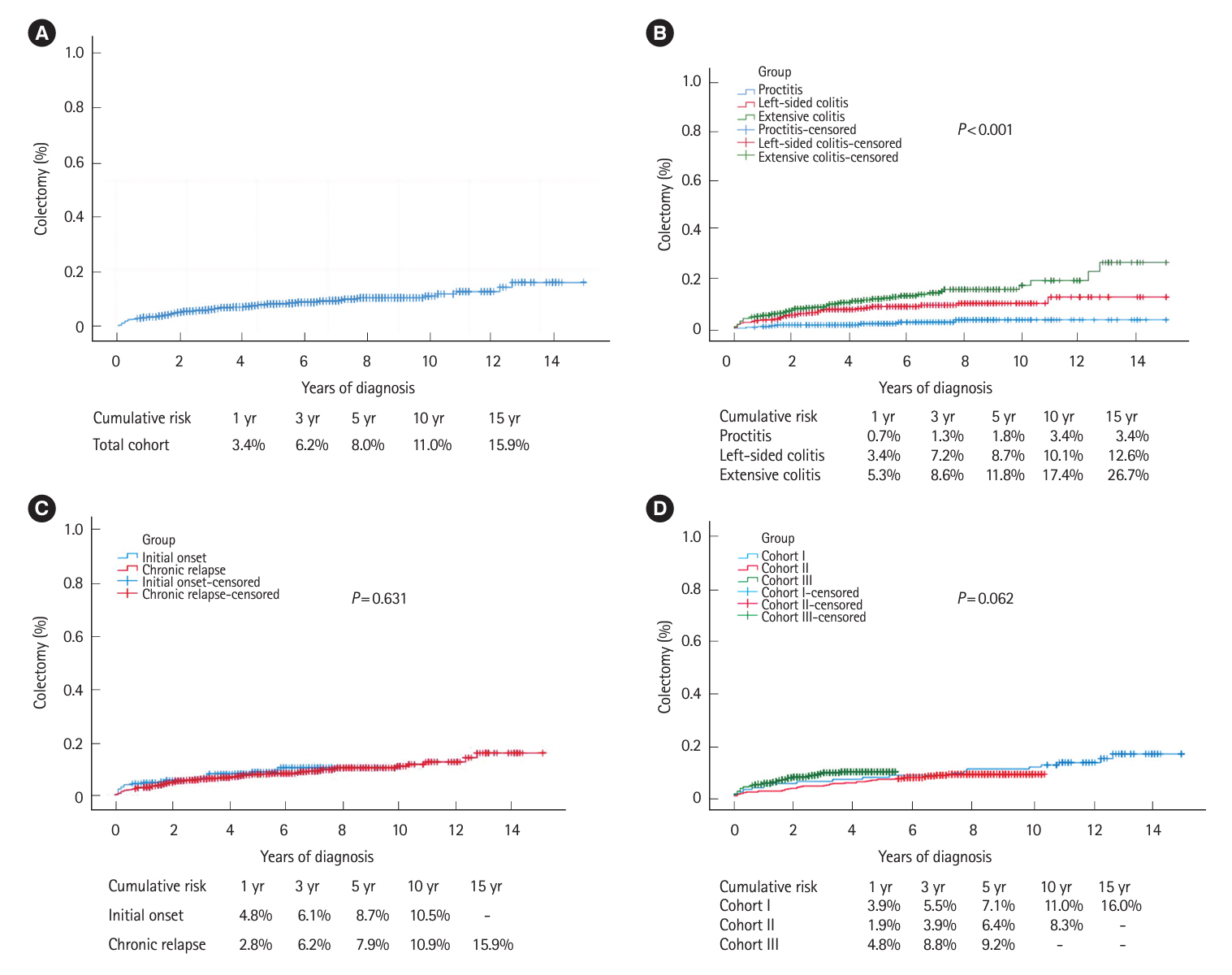Intest Res.
2024 Jul;22(3):357-368. 10.5217/ir.2023.00106.
Changes in the clinical course and prognosis of ulcerative colitis in Chinese populations: a retrospective cohort study
- Affiliations
-
- 1Department of Gastroenterology, The Sixth Affiliated Hospital, Sun Yat-sen University, Guangzhou, China
- 2Guangdong Provincial Key Laboratory of Colorectal and Pelvic Floor Diseases, The Sixth Affiliated Hospital, Sun Yat-sen University, Guangzhou, China
- 3Biomedical Innovation Center, The Sixth Affiliated Hospital, Guangzhou, China
- KMID: 2558195
- DOI: http://doi.org/10.5217/ir.2023.00106
Abstract
- Background/Aims
Data on the natural course of Chinese patients with ulcerative colitis (UC) was lacking. This study aimed to evaluate the natural history and prognosis of patients with UC in the past 15 years in China.
Methods
This cohort study included patients with UC in a tertiary hospital in southern China from 2007 to 2021 (cohort I: 2007–2011, cohort II: 2012–2016, cohort III: 2017–2021). Patients’ clinical characteristics and natural history were analyzed retrospectively.
Results
Of 1,139 included patients, 683 patients presented with proctitis or left-sided colitis at diagnosis and 38.5% of them (263/683) developed proximal disease extension. Fifty-eight percent of patients experienced relapse, chronic continuous and intermittent active course. Five patients (0.4%) developed colorectal tumors/dysplasia. The overall surgery rate was 8.6%, and the rates were 14.2%, 7.8%, and 8.0% in the 3 cohorts, respectively (P= 0.059). Average time from diagnosis to surgery decreased from cohorts I to III (144 months vs. 36 months, P< 0.001), so did the use of glucocorticoids (58.2% vs. 43.5%, P< 0.001) and immunosuppressants (14.1% vs. 13.4%, P= 0.016), and days of hospitalization (13 days vs. 9 days, P< 0.001). Biologics were used more frequently during the first year (0.8%, 2.1%, and 13.7% for cohorts I to III, respectively; P< 0.001). The rate of mucosal healing increased over time.
Conclusions
In Chinese UC patients, one-third of patients experienced proximal disease extension. The rates of malignancy and mortality were low. More biologics were used, while use of immunosuppressants and glucocorticoids were reduced over time. Early biologics use seemed to promote mucosal healing, but the rate of colectomy has not dramatically decreased.
Figure
Reference
-
1. Baumgart DC, Carding SR. Inflammatory bowel disease: cause and immunobiology. Lancet. 2007; 369:1627–1640.
Article2. Kaplan GG. The global burden of IBD: from 2015 to 2025. Nat Rev Gastroenterol Hepatol. 2015; 12:720–727.
Article3. Sood A, Midha V, Sood N, Bhatia AS, Avasthi G. Incidence and prevalence of ulcerative colitis in Punjab, North India. Gut. 2003; 52:1587–1590.
Article4. Park SH, Kim YJ, Rhee KH, et al. A 30-year trend analysis in the epidemiology of inflammatory bowel disease in the Songpa-Kangdong district of Seoul, Korea in 1986-2015. J Crohns Colitis. 2019; 13:1410–1417.
Article5. Zhao J, Ng SC, Lei Y, et al. First prospective, population-based inflammatory bowel disease incidence study in mainland of China: the emergence of “Western” disease. Inflamm Bowel Dis. 2013; 19:1839–1845.6. Du L, Ha C. Epidemiology and pathogenesis of ulcerative colitis. Gastroenterol Clin North Am. 2020; 49:643–654.
Article7. Inflammatory Bowel Disease Group; Chinese Society of Gastroenterology; Chinese Medical Association. Chinese consensus on diagnosis and treatment in inflammatory bowel disease (2018, Beijing). J Dig Dis. 2021; 22:298–317.8. Eriksson C, Cao Y, Rundquist S, et al. Changes in medical management and colectomy rates: a population-based cohort study on the epidemiology and natural history of ulcerative colitis in Örebro, Sweden, 1963-2010. Aliment Pharmacol Ther. 2017; 46:748–757.
Article9. Magro F, Gionchetti P, Eliakim R, et al. Third European evidence-based consensus on diagnosis and management of ulcerative colitis. Part 1: definitions, diagnosis, extra-intestinal manifestations, pregnancy, cancer surveillance, surgery, and ileo-anal pouch disorders. J Crohns Colitis. 2017; 11:649–670.
Article10. Satsangi J, Silverberg MS, Vermeire S, Colombel JF. The Montreal classification of inflammatory bowel disease: controversies, consensus, and implications. Gut. 2006; 55:749–753.
Article11. Burisch J, Ungaro R, Vind I, et al. Proximal disease extension in patients with limited ulcerative colitis: a Danish population-based inception cohort. J Crohns Colitis. 2017; 11:1200–1204.
Article12. Wewer MD, Langholz E, Munkholm P, Bendtsen F, Benedict Seidelin J, Burisch J. Disease activity patterns of inflammatory bowel disease: a Danish nationwide cohort study 1995-2018. J Crohns Colitis. 2023; 17:329–337.
Article13. Solberg IC, Lygren I, Jahnsen J, et al. Clinical course during the first 10 years of ulcerative colitis: results from a populationbased inception cohort (IBSEN Study). Scand J Gastroenterol. 2009; 44:431–440.
Article14. Cha JM, Park SH, Rhee KH, et al. Long-term prognosis of ulcerative colitis and its temporal changes between 1986 and 2015 in a population-based cohort in the Songpa-Kangdong district of Seoul, Korea. Gut. 2020; 69:1432–1440.
Article15. Ayres RC, Gillen CD, Walmsley RS, Allan RN. Progression of ulcerative proctosigmoiditis: incidence and factors influencing progression. Eur J Gastroenterol Hepatol. 1996; 8:555–558.16. Anzai H, Hata K, Kishikawa J, et al. Clinical pattern and progression of ulcerative proctitis in the Japanese population: a retrospective study of incidence and risk factors influencing progression. Colorectal Dis. 2016; 18:O97–O102.
Article17. Qiu Y, Chen B, Li Y, et al. Risk factors and long-term outcome of disease extent progression in Asian patients with ulcerative colitis: a retrospective cohort study. BMC Gastroenterol. 2019; 19:7.
Article18. Ordás I, Eckmann L, Talamini M, Baumgart DC, Sandborn WJ. Ulcerative colitis. Lancet. 2012; 380:1606–1619.
Article19. Singleton JW, Law DH, Kelley ML Jr, Mekhjian HS, Sturdevant RA. National Cooperative Crohn’s Disease Study: adverse reactions to study drugs. Gastroenterology. 1979; 77(4 Pt 2):870–882.
Article20. Leung CM, Tang W, Kyaw M, et al. Endoscopic and histological mucosal healing in ulcerative colitis in the first year of diagnosis: results from a population-based inception cohort from six countries in Asia. J Crohns Colitis. 2017; 11:1440–1448.
Article21. Frøslie KF, Jahnsen J, Moum BA, Vatn MH; IBSEN Group. Mucosal healing in inflammatory bowel disease: results from a Norwegian population-based cohort. Gastroenterology. 2007; 133:412–422.
Article22. Korelitz BI. Mucosal healing as an index of colitis activity: back to histological healing for future indices. Inflamm Bowel Dis. 2010; 16:1628–1630.
Article23. Portela F, Magro F, Lago P, et al. Ulcerative colitis in a Southern European country: a national perspective. Inflamm Bowel Dis. 2010; 16:822–829.
Article24. Barreiro-de Acosta M, Magro F, Carpio D, et al. Ulcerative colitis in northern Portugal and Galicia in Spain. Inflamm Bowel Dis. 2010; 16:1227–1238.25. Romberg-Camps MJ, Dagnelie PC, Kester AD, et al. Influence of phenotype at diagnosis and of other potential prognostic factors on the course of inflammatory bowel disease. Am J Gastroenterol. 2009; 104:371–383.
Article26. Monstad IL, Solberg IC, Cvancarova M, et al. Outcome of ulcerative colitis 20 years after diagnosis in a prospective population-based inception cohort from South-Eastern Norway, the IBSEN Study. J Crohns Colitis. 2021; 15:969–979.
Article27. Ng SC, Zeng Z, Niewiadomski O, et al. Early course of inflammatory bowel disease in a population-based inception cohort study from 8 countries in Asia and Australia. Gastroenterology. 2016; 150:86–95.
Article28. Ng SC, Leung WK, Shi HY, et al. Epidemiology of inflammatory bowel disease from 1981 to 2014: results from a territorywide population-based registry in Hong Kong. Inflamm Bowel Dis. 2016; 22:1954–1960.29. Hoie O, Wolters FL, Riis L, et al. Low colectomy rates in ulcerative colitis in an unselected European cohort followed for 10 years. Gastroenterology. 2007; 132:507–515.
Article30. Samuel S, Ingle SB, Dhillon S, et al. Cumulative incidence and risk factors for hospitalization and surgery in a population-based cohort of ulcerative colitis. Inflamm Bowel Dis. 2013; 19:1858–1866.
Article31. Biondi A, Zoccali M, Costa S, Troci A, Contessini-Avesani E, Fichera A. Surgical treatment of ulcerative colitis in the biologic therapy era. World J Gastroenterol. 2012; 18:1861–1870.
Article32. Leeds IL, Sundel MH, Gabre-Kidan A, et al. Outcomes for ulcerative colitis with delayed emergency colectomy are worse when controlling for preoperative risk factors. Dis Colon Rectum. 2019; 62:600–607.
Article33. Hatch QM, Ratnaparkhi R, Althans A, et al. Is modern medical management changing ultimate patient outcomes in inflammatory bowel disease? J Gastrointest Surg. 2016; 20:1867–1873.
Article34. Liu G. Standardized surgical treatment of ulcerative colitis. Clin Focus. 2016; 31:843–846.35. Harbord M, Eliakim R, Bettenworth D, et al. Third European evidence-based consensus on diagnosis and management of ulcerative colitis. Part 2: current management. J Crohns Colitis. 2017; 11:769–784.
Article36. Zhang Q, Sha S, Xu B, Liang S, Wu K. Prevalence of colorectal cancer in patients with ulcerative colitis: a retrospective, monocenter study in China. J Cancer Res Ther. 2015; 11:899–903.
Article37. Zhang H, Zhang M, Chen X, et al. Risk of malignancy in patients with inflammatory bowel disease: a population-based cohort study from China. Int J Cancer. 2022; 150:1770–1778.
Article38. Fang S, Wu KC, Shi YQ, et al. Analysis of clinical features of 43 cases of inflammatory bowel disease complicated with intraand extra-intestinal tumors. Chin J Dig. 2022; 42:777–782.39. Hovde Ø, Småstuen MC, Høivik ML, et al. Mortality and causes of death in ulcerative colitis: results from 20 years of follow-up in the IBSEN Study. Inflamm Bowel Dis. 2016; 22:141–145.
- Full Text Links
- Actions
-
Cited
- CITED
-
- Close
- Share
- Similar articles
-
- Pathophysiology of ulcerative colitis - Relationship with genetics and immunity
- A case of ulcerative colitis
- A Case of Cytomegalvirus Colitis Developed during the Treatment of Ulcerative Colitis
- Trends in the incidence of ulcerative colitis in Korea
- A Case of Malignant Lymphoma in Patient with Ulcerative Colitis





